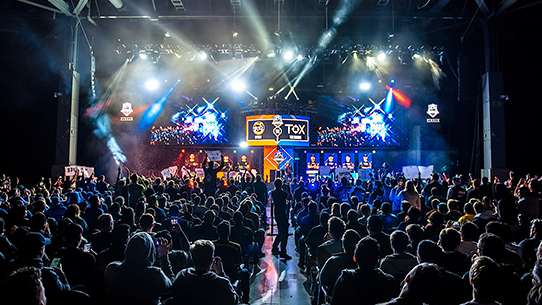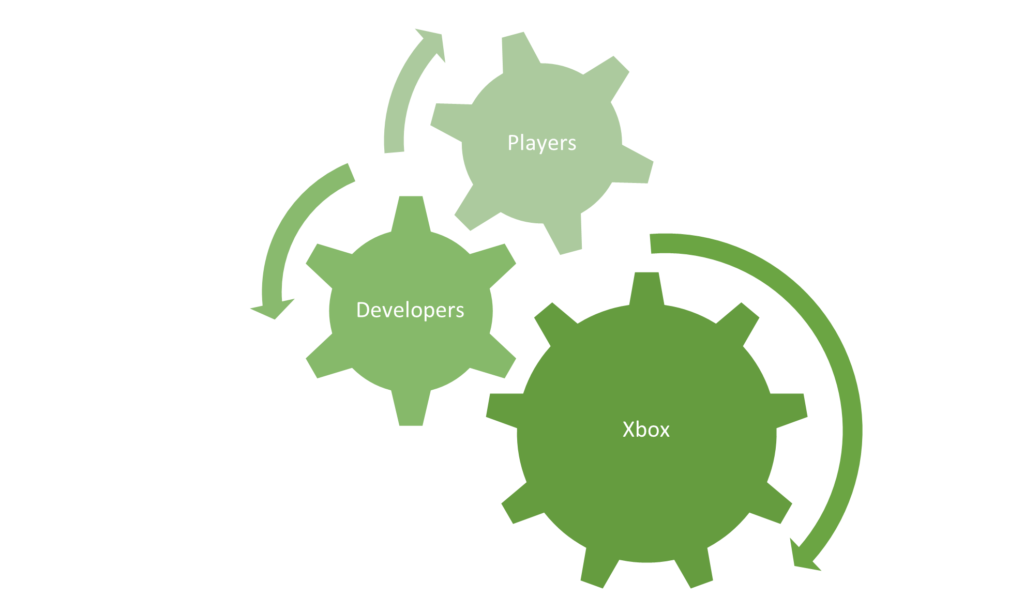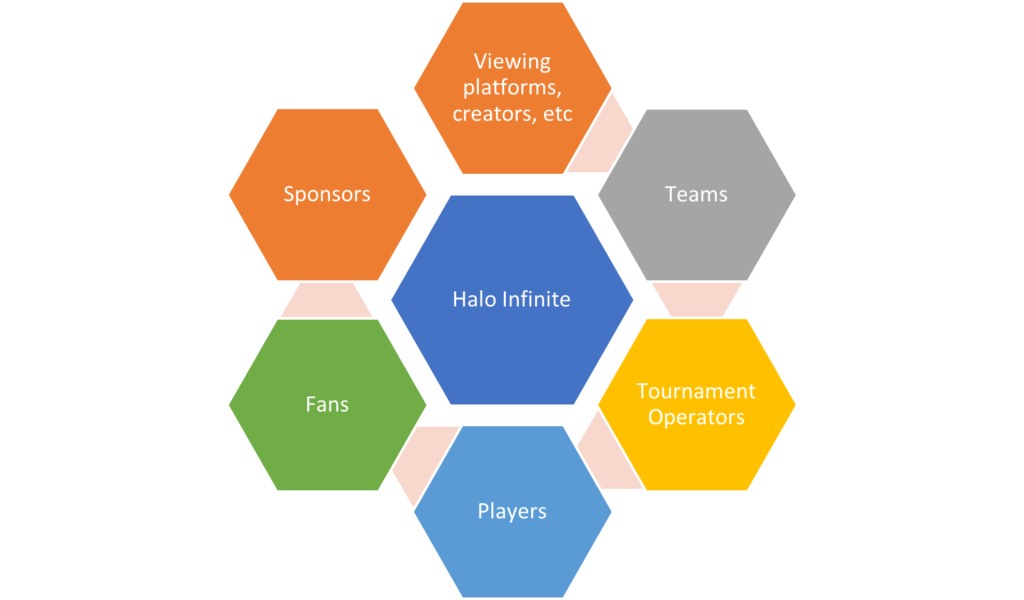Designing the Halo Esports Ecosystem-January

Welcome to the first installment in the Designing the Halo Esports Ecosystem blog series where month by month we will do a deep dive examination into how we at 343 Industries are working to develop a healthy and sustainable long-term esports ecosystem for Halo Infinite. The main focus of today’s blog is to set the foundation for how we think about the ecosystem as a whole, and details our mission, our overall goals, and more. The core of his blog and specific sections like Our Mission and Goals were ripped straight from our Power Point presentations that we share internally as well as with external partners. If you’re interested in our philosophical approach to esports as a fan, player, and even potential partnered team, sponsor, tournament operator or otherwise, then this blog is likely up your alley. We know there are some folks who are just interested in seeing the roadmap and format – we totally understand but fair warning, this blog might not be for you. That information will come down the road as we get closer to launch, and you can get the latest on that (and some more items) in last month’s Community Update.
Let’s get right into it!
OUR MISSION

Our mission is to provide epic entertainment to Halo fans through the thrill of competition.
We believe in:
- Cultivating and uniting communities
- Providing sustained content for fans around the world to watch
- Creating a platform for players, teams, and partners in the ecosystem to thrive on.
PROGRAM GOALS
These are the goals and how we will determine the success of the program and ecosystem. Success in these areas means we can expand and grow over time, failure in these areas means we may need to rethink our approach.
- Extend engagement outside of our games with players, and potential players. (Viewership and social media impressions/reach)
- Build a platform that players, teams, sponsors, tournament operators, and content creators can sustain successful businesses around. (Participating and investing in Halo needs to provide returns based on their goals)
- Build a vision and aspiration for our fans, players, and gamers to create a movement. (We want to create as many 1 + 1 = 3 scenarios as possible. If we all band together, we can truly create something special)
- Create exciting and epic moments in gaming culture. (When are the times we are creating a moment and capturing the attention of the greater online gaming community?)
- Player retention, loyalty, engagement, and more in-game. (The development team will own these goals more than the esports team, but still important for us to track and contribute to.)
WHAT’S A PLATFORM?
You might have heard about certain things in tech being called “platforms”, like Xbox for example. Try to imagine all of the different people and groups who see the Xbox as a valuable platform to invest their time and money into. If you’re a player, you want to get enjoyment out of your Xbox with the games you play and apps that you invest your time and dollars into. As a developer, you invest a lot of resources to bring your games to the Xbox platform either as multiplatform or exclusive.

Now, try to imagine all the things that Xbox does to provide value back to these groups. For players, the Xbox team created the most powerful console ever in the Series X and also put a ton of work into backwards compatibility – both of which are great for players. For developers, the Xbox platform is easy to develop for, and offers a ton of power to give developers the freedom to make great games. Having the games be great is also very valuable to players as well, and thus Xbox is providing “indirect” value to players that way. By putting out great games on a platform that has a lot of players, the developer has an opportunity to see a return on their investment. This is just a tiny snapshot of the overall picture, but hopefully you can start to see the dynamics of how platforms work and how interconnected all of the different groups are. And not only are they interconnected, they depend on each other for their success in the ecosystem, this is a critical component.
This is the type of platform we have been working to create for Halo Infinite esports, but obviously with our own set of groups and means to provide value to those groups.
THE KEY GROUPS
For the launch of Halo Infinite esports, who are the key groups or audiences that invest their time and money into Halo that we need to provide value back to?
- Players (Pro, Amateur, and general competitive players): This one is obvious. The players are central to the entire ecosystem and without a healthy player base for the entire game, the ecosystem is not sustainable. This is mission critical.
- Fans (Viewers, Event Spectators, fans who engage in-game): Fans and viewers are also critical – we want as many people watching Halo Infinite tournaments and content as possible, and it’s important for us to take strides to increase viewership.
- Teams (Tier 1 and Tier 2 esports teams)
- Tournament Operators (Live event operators, online tournament platforms, and HCS Grassroots partners)
- Sponsors (Endemic to gaming/esports, as well as non-endemic)
- Other (Viewing platforms, Content Creators, Talent)

Once we identified these groups we started to think about and talk to them about what their goals are, what they were trying to accomplish, and how Halo can help them achieve their goals. From there, we were able to see how one group could provide value to back to us to meet our goals directly, or indirectly by providing value to another group. The priority is finding ways for one group to provide value directly to another group first. As an example, it’s more important that teams use funding to support their roster and fans, than it is for funding to go directly to us or other partners in the ecosystem.
This is just a high-level overview, and we’ll do a deeper dive on each of the key groups in the upcoming blogs so you can get a more granular view of the relationship and our approach with each of the groups.
OUR ROLE
While we truly believe that we need to all rely on each other in order to have a successful Halo esports ecosystem, we understand that we play a larger role and have a larger impact than any of the other groups. So, what do we at 343 Industries consider our role in the ecosystem to be?
- Developers: First and foremost, we are of course the makers of the game which is at the center of this all. It’s our responsibility to create a great Halo game that fans and players love. The esports team specifically does not develop the game, but we consult on various aspects including features and gameplay, and we provide insights from the competitive community.
- Architects: From an esports perspective, we see ourselves as the architects of the ecosystem. It’s our responsibility to identify the puzzle pieces and work to make them fit together. How do teams fit in? How to tournament operators fit in? That’s on us, and that thinking is really the foundation of the esports ecosystem. Ultimately however, we don’t own the decisions of the each of the groups, we try to provide the best opportunities possible for them. And finally, as architects we also believe it’s our duty to take in feedback, and be the catalysts for growth and improvement in the ecosystem.
- Sanctioning body: We are also the central sanctioning body for the ecosystem. While there are many tournament organizers big and small, we determine who runs official HCS tournaments and dictate the rules and regulations for those tournaments including but not limited to format, game settings, and Code of Conduct. We don’t want this to seem as a sort of dictator-like function however, we are collaborators in the space and work closely with our tournament operator partners to determine the best way forward. And of course, we are closely partnered with Esports Engine who are our main partners in the ecosystem and really act as an extension of the 343 Esports team.
- Broadcasters: Additionally, we are the main broadcasters for Halo esports. That means for official HCS events, it’s our responsibility to decide the broadcast scope and execute on it alongside our operator partners of course. It’s important to us that we’re not the only ones broadcasting in the ecosystem however, as we generally believe that the more broadcasters covering matches in the Halo Infinite ecosystem the better. Finally, we also determine broadcast talent for official HCS shows, and overall creative direction and tone for those shows.
OPEN ECOSYSTEM
By now you’ve probably realized that Halo Infinite esports is an open ecosystem. This means that while we don’t officially partner with everyone in the ecosystem, we do not control who enters and leaves the ecosystem. To provide an example, if a brand new team organization decided that they wanted to pick up a pro Halo roster and earn their way to the championship, then that’s totally ok. If you’re a long-time competitive Halo fan you might be thinking, “well yea, that’s just how it’s always worked right?” and the answer is yes. This is consistent with the legacy of Halo esports and not only touches on organizations like teams and tournament operators, but also players. Halo esports was built on open tournament structures where any group of players could work their way up to the top and would have opportunities to play against the best in the world. This will still be true for Halo Infinite esports. Esports as an industry has continued to evolve and grow however, and while there are some leagues that more closely resemble closed ecosystems like you see in traditional sports, Halo Infinite’s journey will begin as an open ecosystem. We are however, as noted above and will be detailed in future blogs, partnering more closely with groups in the ecosystem than Halo ever has in the past.

Ultimately this decision was based on where the ecosystem is at today and what we’re trying to accomplish. If some numbers of years down the road we decide the best way to improve and grow the sport and ecosystem is to change our approach, then we will adjust our strategy. For now, Halo Esports will be an open ecosystem, and we’re very thankful for the groups that want to participate in it.
CLOSING
Well, that will do it for the first entry in this blog series. We made a promise to be more transparent about our plans and intentions and we hope you enjoyed and appreciated this look behind the curtains.
As this is the first in the series, we’d appreciate hearing your thoughts overall. Did you enjoy it? Do you have any more questions about our goals, ecosystem design, and platform aspirations? Hit us up on twitter and we’ll work to incorporate answers in future blogs.
Thanks – see you online!
-Tashi
